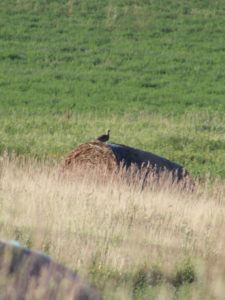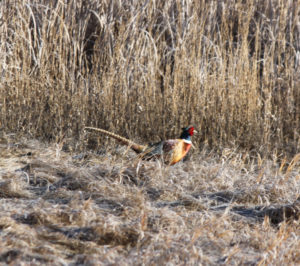
Mourning doves will roost in the protected areas of the prairie, such as shelterbelts and farm groves. Intercept them as they move from these places to food and water sources in the morning and evening. Simonson Photo
By Nick Simonson
Hunts are best viewed in hindsight. The thrill of the flush and the clamor of the shot often overpower the memory of the longer, quieter stretches of the walk leading up to those moments. But it is in that prologue to the excitement where we begin to realize what came together to make those thrilling instants happen. This autumn, as upland game season starting dates begin to peel off the calendar – starting with this week’s mourning dove opener on Sept. 1 – keep in mind the big four for all upland species, to help set up more of those memorable moments. While each species of upland game varies, the four things they look for are: food, water, cover and grit.
The last factor is easy for most upland birds to locate and also for hunters to identify. A gravel road bounding a wildlife management area, or a sandy stretch along a creek provides plenty for pheasants and grouse of both types to grind their grainy foods in digestion; but keep it in the back of your mind while hunting that any source of grit is a plus-one in the upland equation for a good hunting area. It’s the other three that often provide a challenge in identifying the food, water and cover that goes into an excellent space to explore for upland birds, and those factors certainly vary from species to species.
Doves
Being the smallest of the five primary upland species in the upper Midwest, mourning doves eat smaller things. When staking out a spot to set up for an evening hunt, consider that diet. Identify spaces near small grain fields of canola, wheat, or sunflowers which provide the base forage for these migrating birds. Water plays a key role in mourning dove hunts, as the birds will head to a hydration source in the morning and evening, so identify seeps, springs, and both natural and manmade ponds where the birds will come to. Set up a decoy spread and a concealed spot around them to intercept doves in their daily movements. Cover for doves is key too, and large shelterbelts and farm groves will hold them during the day. Watching their movements from spot to spot, or from field to roost will provide tips on their travels.
Partridge
Hungarian partridge, while sadly becoming more of a rarity on a changing landscape, remain the ultimate edge bird. Shorter in stature than their upland contemporaries, they key in on small grains like wheat and oats, where available. Adapted to the demands of more arid conditions, they get most of the water they need from their forage which includes green leaves in addition to agricultural sources, along with moisture generated by dew, so an obvious water source isn’t a necessity in a good hunting spot for these upland birds. As a result, look for their fall flocks to congregate under the cover of shorter grasses adjacent to wheat fields, especially those where the stalks of the harvested fields have been left taller to provided added cover.
Sharptailed Grouse

Sharptailed grouse get much of their moisture from green, leafy plants. That makes grassy areas next to alfalfa fields ideal habitat to hunt for these early-season upland birds. Simonson Photo
Sharpies are the birds of the open prairie but love a good lookout in the middle of it or on its edge. Finding those fields of rolling knee-high grasses that are dotted with buckbrush and buffaloberry bushes is always worth a mark on the GPS. This habitat provides the flock plenty of cover for their mid-sized bodies and allows a sentry to post up in an elevated position to watch for trouble. While sharptails will eat most agricultural overflow, smaller grains like wheat, peas and soybeans are a draw. They too get a great deal of their required moisture from green leaves, and any stretch of CRP next to an alfalfa field is worth a walk because of that. Plus, plenty of late-season grasshoppers are often associated with those adjacent green leaves and are still consumed by growing grouse from this year’s hatch until the first hard frost knocks insect populations back.
Ruffed Grouse
While one of these upland birds is not like the others simply due to its home range, it shares many of the same proclivities, just on a grander scale. The ruffed grouse, like the ringneck pheasant, is an edge creature, however its edges are trees of the northern forests as opposed to ground cover of the prairie. Surviving mostly on aspen buds and forest greens, along with berries such as highbush cranberries, the ruffed grouse somehow turns nature’s most bitter crops into the best upland game meat. Thus, look for thunderbirds in those spaces where pine turns to popple, or those aspens give way to open areas with highbush or other berry plants along a meandering forest creek where they also get their water in addition to leaf-borne condensation. In the early morning or afternoon, ruffies will dry off along an opening in the woods or forage and get grit in those spaces, such as a logging trail, clear cut, or natural meadow. Walk the edge of the trees and its likely you’ll find one, or a small group together in those openings, particularly in the early part of the hunting season.
Ringneck Pheasants

Ringneck pheasants are the ultimate upland edge bird. Depending on conditions, they’ll utilize heavier cover to stay warm and then move into lighter grasses as the day progresses and temperatures rise. Knowing their preferred habitat and feeding schedule will help hunters find more success. Simonson Photo.
The ultimate edge creature in upland hunting is also the most pursued. The ringneck pheasant is notable for occupying those spaces where field meets grass, or where that low cover meets denser stands of cattails, cane, or willow thickets. On cold nights or after a snow in late season, plan on your hunts to start in those thicker areas. When things are warmer at the season’s start, light grasses to waist-high CRP will hold birds moving freely about between roosting areas such as shelterbelts, brush lines, and farm groves, to food sources that run the agricultural gamut. The modern two-crop focus of corn and soybeans has benefitted these bigger birds, but they will also eat wheat, peas and other smaller items. A water source such as a stock pond or small creek surrounded by tall grass is a good area to mark on a walking map as well, as pheasants will look for additional hydration beyond what they consume.
This season, as walks and hunts for upland species get underway, consider the four elements these birds require. Knowing their preferred habitat, the food they consume, where they get their water, and that additional consideration of grit will help lead to the more exciting part of the hunt when the cover explodes with the beating of wings and a smoky shot rings out, heralding the start of a new season…in our outdoors.
